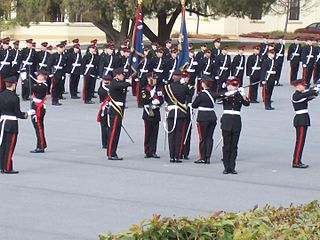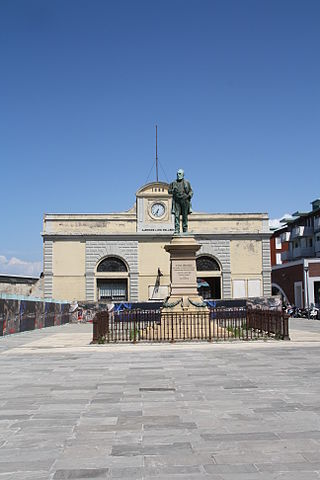
A military academy or service academy is an educational institution which prepares candidates for service in the officer corps. It normally provides education in a military environment, the exact definition depending on the country concerned.

The Italian Air Force is the air force of the Italian Republic. The Italian Air Force was founded as an independent service arm on 28 March 1923 by King Victor Emmanuel III as the Regia Aeronautica. After World War II, when Italy became a republic following a referendum, the Regia Aeronautica was given its current name. Since its formation, the service has held a prominent role in modern Italian military history. The acrobatic display team is the Frecce Tricolori.

The Italian Navy is the navy of the Italian Republic. It is one of the four branches of Italian Armed Forces and was formed in 1946 from what remained of the Regia Marina after World War II. As of August 2014, the Italian Navy had a strength of 30,923 active personnel, with approximately 184 vessels in service, including minor auxiliary vessels. It is considered a multiregional and a blue-water navy.

The Regia Marina (RM) or Royal Italian Navy was the navy of the Kingdom of Italy from 1861 to 1946. In 1946, with the birth of the Italian Republic, the Regia Marina changed its name to Marina Militare.

Nikola Vaptsarov Naval Academy (NVNA) is the oldest technical educational institution in the Republic of Bulgaria. Its history, past and present achievements establish the institution as the most prestigious centre for training maritime specialists in the country. Its development over the years resembles a navigable river, into which many tributaries flow, as well as the "prototypes" of the present-day faculties, departments, and vocational colleges constituting the Nikola Vaptsarov Naval Academy.

Inigo Campioni was an Italian naval officer during most of the first half of the 20th century. He served in four wars, and is best known as an admiral in the Italian Royal Navy during World War II. He was later executed by the Italian Social Republic for refusing to collaborate.
Bruno Branciforte is an Italian admiral. He was Chief of Staff of the Italian Navy from 23 February 2010 to 2 March 2012 and he succeeded to Nicolò Pollari as the last head of the Italian Military Intelligence and Security Service (SISMI), nominated by Prime Minister Romano Prodi, from 21 November to 2006 to 3 August 2007 when the Agency was dissolved and transformed into the Italian External Intelligence and Security Agency (AISE). He was also the first director of AISE from 4 August 2007 to 4 February 2010.

Costanzo Ciano, 1st Count of Cortellazzo and Buccari was an Italian naval officer and politician. He was the father of Galeazzo Ciano.

Giuseppe Fioravanzo was an Italian admiral. He was considered one of the main "intellectuals" of the Regia Marina; together with admirals Bernotti and Di Giamberardino he was one of the main authors of the development of Italian naval doctrine between the two World Wars. After serving with distinction in the Italo-Turkish War and the First World War, from the 1920s he started his activity as a naval theorist and writer besides continuing his military career. During the Second World War, having been promoted to Divisional Admiral, he held important commitments, both operational and related to General Staff. After the war he directed the Historical Office of the Italian Navy for many years.

Ernesto BurzagliCB GCMM GOA was a prominent figure in the Kingdom of Italy during the early 20th century. During a lifetime career in the Italian Royal Navy, he rose to the rank of admiral and chief of staff. In 1933, King Victor Emmanuel III appointed Burzagli as a senator in Rome.

Domenico Cavagnari was an Italian admiral and the Chief of Staff of the Regia Marina from 1934 until 1940.
Accademia often refers to:

Cantiere navale fratelli Orlando is a historical Italian shipyard in Livorno.
The following is the structure of the Italian Navy as of June 2020. It is considered a multiregional and a blue-water navy.
The Corpo Reali Equipaggi Marittimi, also known as Corpo Regi Equipaggi Marittimi or Corpo Reali Equipaggi di Marina (CREM), was the corps that comprised non-commissioned officers and enlisted men of the Regia Marina. It operated the Royal Italian Navy's schools for specialists, such as gunners, mechanics, electricians, radio operators, sonar operators, carpenters, firemen, paymasters, nurses, motormen, helmsmen, deep-sea divers, signalmen, and rangefinder operators. Its schools were located in Venice, La Spezia and Pola.

Giuseppe Valle was an Italian Air Force general during the interwar period, Chief of Staff of the Regia Aeronautica from 1928 to 1939 and State Undersecretary for the Air Force from 1933 to 1939. He was also a member of the Chamber of Fasces and Corporations.
Ruggero Bonomi was an Italian Air Force general during the Spanish Civil War and World War II. He was deputy commander of the Corpo Aereo Italiano and commander of the Auxiliary Naval Air Force; after the Armistice of Cassibile he became the last State Undersecretary for the Air Force of the Italian Social Republic.

Count Pasquale Leonardi Cattolica was an Italian admiral and politician. He was Minister of the Navy of the Kingdom of Italy during the Italo-Turkish War.

Count Rufo Pompeo Provana del Sabbione was an Italian admiral and senator who briefly served as Minister of the Navy in 1867 and 1868.

















